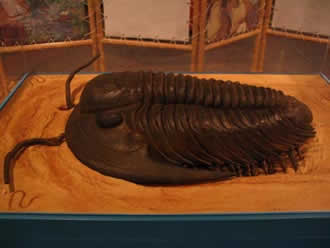| | TRILOBITES |
| |
| | Trilobites were a dominant form of life in
the oceans for about 270 million years. They appeared in the Cambrian sea more than 500 million
years ago and finally died out near the end of the Permian Period, during an extinction that wiped
out 95% of species in ocean. The fossil remains of trilobites tell us they were among the most fascinating
and diverse of all creatures to have inhabited the earth. Rolled up or flattened, rounded or spiny,
trilobite fossils come in a bewildering variety of shapes and sizes. After all they had almost 300 million years
of genetic experimentation to work with! |
 |
| | |
| | Trilobites have been responsible for nurturing
the early years of many a fossil hunter. Two of Canada's best palaeontologists are among them. During
the late 1800's George Matthew and his son William collected most of the trilobites in the New
Brunswick Museum collection. The Cambrian rocks of southern New Brunswick have given up giant
trilobites like Paradoxides regina, blind trilobites like Conocoryphe elegans and
miniature trilobites like Agnostus acadicus. Today palaeontologists still unravel the complex
geology of New Brunswick using trilobite fossils as their guides. |
| |
| |  |
|
| |
|